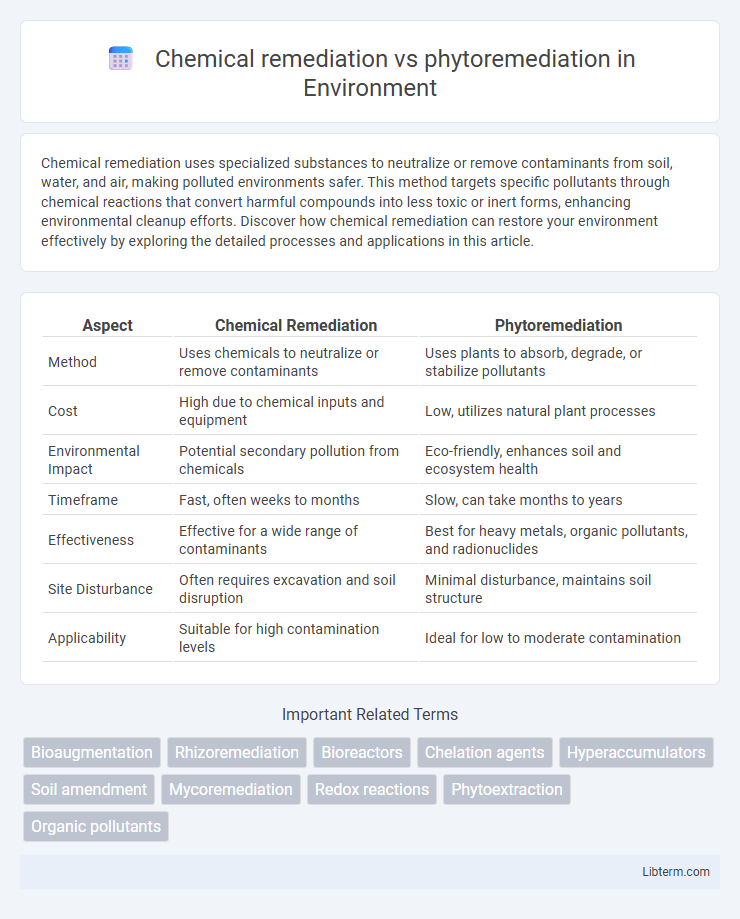Chemical remediation uses specialized substances to neutralize or remove contaminants from soil, water, and air, making polluted environments safer. This method targets specific pollutants through chemical reactions that convert harmful compounds into less toxic or inert forms, enhancing environmental cleanup efforts. Discover how chemical remediation can restore your environment effectively by exploring the detailed processes and applications in this article.
Table of Comparison
| Aspect | Chemical Remediation | Phytoremediation |
|---|---|---|
| Method | Uses chemicals to neutralize or remove contaminants | Uses plants to absorb, degrade, or stabilize pollutants |
| Cost | High due to chemical inputs and equipment | Low, utilizes natural plant processes |
| Environmental Impact | Potential secondary pollution from chemicals | Eco-friendly, enhances soil and ecosystem health |
| Timeframe | Fast, often weeks to months | Slow, can take months to years |
| Effectiveness | Effective for a wide range of contaminants | Best for heavy metals, organic pollutants, and radionuclides |
| Site Disturbance | Often requires excavation and soil disruption | Minimal disturbance, maintains soil structure |
| Applicability | Suitable for high contamination levels | Ideal for low to moderate contamination |
Introduction to Environmental Remediation
Chemical remediation employs synthetic agents or processes to break down or remove pollutants rapidly from contaminated sites, offering precise control and effectiveness in treating diverse hazardous substances. Phytoremediation utilizes specific plants to absorb, accumulate, or degrade contaminants naturally, presenting an eco-friendly and cost-effective alternative with the added benefit of improving soil health and biodiversity. These approaches serve as crucial strategies within environmental remediation to restore polluted ecosystems and reduce human and ecological risks.
Defining Chemical Remediation
Chemical remediation involves the use of chemical agents to neutralize, degrade, or remove contaminants from soil, water, or air, targeting pollutants such as heavy metals, hydrocarbons, and organic compounds. This method often employs oxidizing or reducing chemicals, surfactants, or chelating agents to transform hazardous substances into less toxic or more easily extractable forms. Chemical remediation is typically faster than phytoremediation but may require careful management to prevent secondary environmental impacts.
Understanding Phytoremediation
Phytoremediation utilizes plants to absorb, degrade, or immobilize contaminants from soil and water, offering an eco-friendly and cost-effective alternative to conventional chemical remediation methods. Unlike chemical remediation, which involves synthetic agents to neutralize pollutants, phytoremediation harnesses natural plant processes such as phytoextraction, phytodegradation, and rhizofiltration to restore environmental quality. This sustainable technique is especially effective for heavy metals, organic pollutants, and radionuclides, improving soil health while minimizing secondary pollution risks.
Mechanisms of Chemical Remediation
Chemical remediation utilizes physical and chemical processes such as oxidation, reduction, precipitation, and adsorption to break down or immobilize contaminants in soil and water. These mechanisms often involve injecting chemical agents like oxidants or reductants to transform hazardous substances into less toxic or more stable forms. This approach enables rapid contaminant removal but may require careful management of chemical byproducts and environmental impacts.
Key Processes in Phytoremediation
Phytoremediation utilizes plants to uptake, degrade, or stabilize contaminants in soil and water through processes like phytoextraction, phytodegradation, phytostabilization, and rhizodegradation. Chemical remediation relies on physical or chemical methods such as oxidation, reduction, and neutralization to treat pollutants, often requiring more energy and resources. Key processes in phytoremediation include hyperaccumulation for extracting heavy metals, enzymatic breakdown of organic compounds, and root-associated microbial activity enhancing contaminant degradation.
Advantages of Chemical Remediation
Chemical remediation offers rapid and effective treatment of contaminated sites by utilizing chemical agents to neutralize or remove pollutants, making it suitable for high-concentration hazardous wastes. This method provides precise control over reaction conditions, enabling targeted cleanup of specific contaminants such as heavy metals, hydrocarbons, and chlorinated compounds. Its scalability and adaptability to various environmental settings make chemical remediation a preferred choice for urgent and large-scale remediation projects.
Benefits of Phytoremediation
Phytoremediation offers an eco-friendly and cost-effective alternative to chemical remediation by using plants to absorb, degrade, or immobilize contaminants in soil and water. This method enhances soil health, prevents erosion, and promotes biodiversity while minimizing chemical use and environmental disruption. The natural ability of plants like willows and poplars to uptake heavy metals and organic pollutants makes phytoremediation a sustainable solution for site restoration and pollution control.
Limitations and Challenges of Chemical Remediation
Chemical remediation faces limitations such as high operational costs, potential formation of harmful byproducts, and incomplete degradation of pollutants in soil and water. These techniques often require extensive energy inputs and may disrupt native ecosystems, limiting their applicability in sensitive environments. Challenges also include handling diverse contaminant types and achieving long-term sustainability without secondary pollution.
Constraints and Drawbacks of Phytoremediation
Phytoremediation faces constraints such as limited effectiveness in heavily contaminated soils and slow pollutant removal rates compared to chemical remediation. Its drawbacks include dependency on plant species' tolerance to specific contaminants and environmental conditions, as well as the potential for bioaccumulation leading to secondary pollution risks. Furthermore, phytoremediation is less suitable for complex or mixed contaminant sites requiring immediate or large-scale decontamination.
Comparative Analysis: Chemical Remediation vs. Phytoremediation
Chemical remediation employs synthetic agents like oxidants or reductants to rapidly neutralize contaminants, offering faster results but often at higher costs and potential environmental disruption. Phytoremediation uses plants to absorb, degrade, or immobilize pollutants, providing a cost-effective, eco-friendly solution with slower remediation timelines suited for large-scale or less toxic sites. Both methods vary in efficacy based on contaminant type, site conditions, and cleanup goals, necessitating tailored application for optimal environmental restoration.
Chemical remediation Infographic

 libterm.com
libterm.com